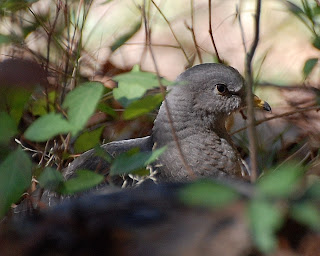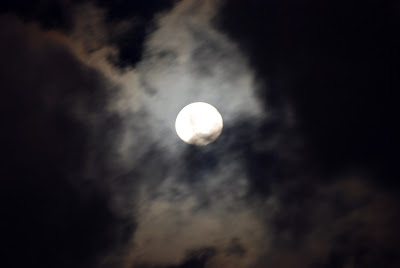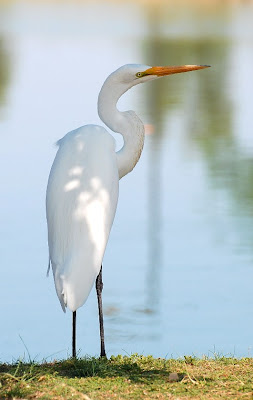Burrowing owls live in underground burrows. While they can be seen during the day, they do most of their hunting at night. They have long legs and big eyes and make a barking sound. You will often find them standing in front of their burrows on one leg with their eyes half closed. Their spotted feathers are perfect camouflage for the mounds of soil they live in. Burrowing owls will often take over abandoned prairie dog dens and can sometimes be found in the middle of prairie dog towns.
Saturday, October 31, 2009
HAPPY HALLOWEEN!
Burrowing owls live in underground burrows. While they can be seen during the day, they do most of their hunting at night. They have long legs and big eyes and make a barking sound. You will often find them standing in front of their burrows on one leg with their eyes half closed. Their spotted feathers are perfect camouflage for the mounds of soil they live in. Burrowing owls will often take over abandoned prairie dog dens and can sometimes be found in the middle of prairie dog towns.
Friday, October 30, 2009
A Pumpkin A Day
Lesser long-nosed bats are an endangered species. As one of the few nectar eating bats they migrate from Mexico every year following the saguaro blooms north and the agave blooms south on their long migration. They breed here in Arizona and return to Mexico for the winter. Lesser Long-nosed bats will often visit your hummingbird feeders in the fall when they are migrating south. It is quite a spectacle to see.
Thursday, October 29, 2009
A Pumpkin A Day
(by Kathiesbirds 10-26-09)
Hummingbird Morning
It was 38 degrees here in Sycamore Canyon when I awoke this morning. As soon as the sun rose the birds started to appear. The temperature dropped sharply yesterday driving the birds into my feeders. There was a feeding frenzy last night just before the last few rays faded from the sky. When the morning sun touched the earth once again the hummingbirds were back to refuel. Hummingbirds usually don't like to share the feeder, but when it is this cold and there are so many, they seem to give up and focus their energy on feeding instead of fighting. Most of these are Costa's hummingbirds, but the one hovering to the right with a central throat patch is actually a female Anna's Hummingbird. How great is it to live someplace where you get hummingbirds in autumn and winter?
 Immature male Anna's Hummingbird 10-29-09
Immature male Anna's Hummingbird 10-29-09Don't mess with me!
Wednesday, October 28, 2009
A Pumpkin A Day
Phainopeplas are insect and berry eating birds found in the Sonoran Desert. The males are black and the females are gray. Both have red eyes. They fly out from a perch to snag insects from the air, or they eat mistletoe berries from the parasitic plants that hang off of other trees. When the phainopeplas go to the bathroom, they excrete mistletoe seeds in their sticky waste onto the branches where they perch. In this way the mistletoe then takes hold and starts to grow on a new tree sending its roots into the new host and sharing the same sap and nutrients. Phainopeplas make a call that sounds like a soft “whoop, whoop.” They are in a family called the silky flycatchers.
Tuesday, October 27, 2009
My World is a World of Art
Broad-billed hummingbirds are found in the streamside foothills, woods, and canyons of the desert southwest. With their beautiful blue and green bodies and broad red bill, they are one of the prettiest hummingbirds to be seen when you visit Arizona.
Gila monsters are lizards that live in the desert southwest. They are one of the only poisonous lizards in the world. However, it is not easy to get poisoned by one of these lizards since its venom sacks are in the back of its mouth and the lizard actually has to bite down and grind with its teeth to deliver the poison. Most Gila monsters will run away from you if they see you so, if you leave them alone there is relatively no danger from this beautiful creature.

Last week when I decided to paint some Halloween cards for my grandchildren and a few other kids in my life I had no idea it would take me so long! I probably spent 4 to 5 days getting all of these done and yesterday I finally got them out in the mail! I can only hope they get to their destinations in time. In the meantime, I decided to share these paintings with all of you, so, the next 5 days there will be A PUMPKIN A DAY here at the Sycamore Canyon Blog. Each painting has a creature that can be found here in Arizona and I've included a little information blurb about each one. All are done in acrylic on Bristolboard. I hope you enjoy this Halloween fun!
Monday, October 19, 2009
My World: Patagonia-Sonoita Creek Preserve
 In the southern Mountains of Arizona lies a small town called Patagonia. Known as a birding and art Mecca, I met TR Ryan there on Friday morning after his two night stay at my house.
In the southern Mountains of Arizona lies a small town called Patagonia. Known as a birding and art Mecca, I met TR Ryan there on Friday morning after his two night stay at my house. The blue adobe walls of the Duquesne House greet me, the front porch strung with red pepper chandeliers,
The blue adobe walls of the Duquesne House greet me, the front porch strung with red pepper chandeliers, I step through the front door of this room into a Mexican heritage museum. I walk out the back door into a court yard from the past with lovely shady places to sit and contemplate…
I step through the front door of this room into a Mexican heritage museum. I walk out the back door into a court yard from the past with lovely shady places to sit and contemplate… While TR wanders the garden, sipping the fragrances of the flowers, listening to the hum of hummingbirds, and the breeze dancing in the trees
While TR wanders the garden, sipping the fragrances of the flowers, listening to the hum of hummingbirds, and the breeze dancing in the trees
We soon pack up and drive the two short miles to The Patagonia-Sonoita Creek Preserve. We are greeted by Cassin’s Kingbirds, canyon towhees, and a lark sparrow, seeking food on the gravel trail.

The trail meanders along Sonoita Creek, one of the few perennial streams in Arizona. As such, it is a precious resource and the Nature Conservancy has purchased it to preserve this fragile habitat. It was the first project undertaken by the Nature Conservancy in Arizona.
 I am surprise by how flat it is, with mountains rising in the distance. But here the golden fields reflect autumn sunlight and shadow, while cicadas buzz in the trees. T.R. tells me this look like Oklahoma in the summer.
I am surprise by how flat it is, with mountains rising in the distance. But here the golden fields reflect autumn sunlight and shadow, while cicadas buzz in the trees. T.R. tells me this look like Oklahoma in the summer. We walk quietly down the soft dirt trail and enter the woods once again.
We walk quietly down the soft dirt trail and enter the woods once again.
Where we find western wood pewees and other flycatchers flitting among the creek side trees.
This is a quiet place, ripe with sunlight, perfect for bugs and birds. I see a woodpecker fly into the thickest trees and disappear before I can identify which species it is. We find a female vermillion flycatcher and an ash-throated flycatcher in the willows and cottonwoods down by the creek.
And then to my surprise on a dead snag overhanging the riffled water, a cedar waxwing perches silently alongside a Says Phoebe! Though I am quite familiar with cedar waxwings, I have never seen one in Arizona. It seem to me a bird out of place, a mixture of north and south, east and west, with the Says’ Phoebe sitting next to it.
If you would like to visit the Patagonia-Sonoita Creek Preserve you get there by taking highway 83 south off of I-10 through Davidson Canyon, an Arizona Scenic highway. In Sonoita turn right on Highway 82 and follow it into Patagonia. Turn right on 4th Avenue to a T intersection. Then turn left and follow the signs to the preserve, about 1 ½ miles down the road.
Info from the Nature Conservancy web site:
Planning Your Visit The elevation at the preserve is 4,000 feet. The best months for birding are March through September. Late April and May, and late August and September, offer the greatest diversity of species, including migrants and spring/summer residents. Winter is the season for sparrows and occasional southern vagrants such as the rufous-backed robin.
Visitors may learn about the preserve, its wild residents, viewing interpretive exhibits at the Visitor Center.
HoursApril-September: Wednesday-Sunday, 6:30 a.m.-4 p.m. October-March: Wednesday-Sunday, 7:30 a.m.-4 p.m. Closed: Mondays & Tuesdays all year & on Thanksgiving, the day after Thanksgiving, Christmas & New Year’s Days.
Fees$5 per person. Conservancy members $3. Patagonia residents and ages 16 & under free. Fees are valid for seven days from date of purchase. Annual passes are available.
Saturday, October 17, 2009
Blog Award From Arija
Beth-Beth's Stories
Bobbie-Almost There
Lynne-Hasty Brook
Mary-Mary's View
Nina-Nature Remains
Wren-Wrenaissance Reflections
And once again, thank you dear Arija! If you have not visited her lovely blog, Garden Delights, you should. It has lovely photography, prose, and poetry.
Thursday, October 15, 2009
Skywatch Friday: October Sky in Madera Canyon
Wednesday, October 14, 2009
Sycamore Canyon Birds
Monday, October 12, 2009
My World: Birding With TR Ryan
 Yellow Warbler in Sycamore Canyon 10-6-09
Yellow Warbler in Sycamore Canyon 10-6-09 American Kestrel in Saguaro National Park's Rincon Mountain Unit
American Kestrel in Saguaro National Park's Rincon Mountain Unit TR walking the Proctor Trail in Madera Canyon 10-7-09
TR walking the Proctor Trail in Madera Canyon 10-7-09
We find this ball of resin clinging to the side of a mesquite tree. I have never seen anything like this.
 Resin ball 10-7-09
Resin ball 10-7-09 Bridled titmouse 10-7-09
Bridled titmouse 10-7-09 Green-tailed Towhee 10-7-09 Proctor Trail
Green-tailed Towhee 10-7-09 Proctor Trail
From here we head farther up into the Canyon to another favorite birding spot: Madera Picnic Area. As soon as we park the car TR gets to see yet another target bird, the Acorn woodpecker. While he jumps out for a better look, I gather my gear and the food and we head down to find a picnic table for a rest and a snack. However, just as soon as I lay my books, bags, and cooler on the table I see something in the shadows of a nearby bush. It is barely 10 feet away from me and my jaw drops open and I start to shake. Can I be seeing what I think I am seeing?
 Juvenile Band-tailed Pigeon 10-7-09
Juvenile Band-tailed Pigeon 10-7-09T.R. is wondering what I am so excited about but I can barely answer him. I have been in pursuit of this species for almost a year, and now here it is, right before my eyes. I see the pigeon's body, but this is no Rock Pigeon or Mourning Dove. "How do you know," asks T.R.? "See the yellow feet and the yellow beak," I say, but something is not right. Where is the banded tail and the white crescent and green iridescence that should be on the back of the neck. Yet it has a yellow beak and yellow feet. Rock pigeons have pink feet and a gray beak. Mourning doves have the same with a pointed tail and speckled wings. As my mind races, all I can think is that this must be a juvenile.
 Juvenile Band-tailed pigeon 10-7-09 Madera picnic area.
Juvenile Band-tailed pigeon 10-7-09 Madera picnic area. Queen Butterfly in Sycamore Canyon Wash 10-8-09
Queen Butterfly in Sycamore Canyon Wash 10-8-09(Thanks Doug!)
Thursday morning dawns bright and clear. The wind has died down so all is calm as T.R. and I head out into the wash. This will be our last hike before he has to leave. We saved Sycamore Canyon for last since we do not have to drive to get there. It is right out my front door. I do not know what we will see, since we have not seen large numbers of species at all in the places we have birded so far, but Sycamore Canyon does not disappoint and soon we are seeing birds everywhere! So many, in fact, that it is hard to keep track of them all. I get on one bird and TR finds another. "What is this," he ask. "Wait a minute, I am not sure what this one is!" I reply. And we spin, and snap and look and list and hike and look some more. We are finding phainopeplas, Gambels' Quail, Gila Woodpeckers, Gilded flickers, Black-tailed gnatcatchers, black-throated sparrows, Costa's hummingbirds, curve-billed thrashers, cactus wrens, turkey vultures and more. Birds are all around us. Birds are everywhere. T.R. wants to see a pyrrhuloxia, and finally we find one when we near the bridge over the wash. We also find a ladder-backed woodpecker, and a lark bunting eating grass seed heads by the side of the road. The lark bunting is in the same area where I had the Unexpected Encounter with the peregrine falcon and I point it all out to him. We are in no hurry and we go at our own pace. T.R. is enjoying the beauty around him. I think the magic of this place has wrapped around his heart.
Saturday, October 10, 2009
Skywatch Friday: Waiting Dawn
 ...while to the north the lights of Tucson still glow in the dim light of dawn...
...while to the north the lights of Tucson still glow in the dim light of dawn... ...and off in the west the full moon sets as a mysterious pearl shrouded in filmy flimsy clouds.
...and off in the west the full moon sets as a mysterious pearl shrouded in filmy flimsy clouds.For more amazing sky views visit
SKYWATCH FRIDAY!
Tuesday, October 6, 2009
My World: Maricopa
 Desert Wind Middle School
Desert Wind Middle SchoolI found myself here last week to do a bird presentation for a friend of mine who teaches 7th grade science in the Desert Wind Middle School.
 I set up the class with some of my paintings, a few issues of Bird Watcher's Digest and a PowerPoint presentation with photos from my blog and my bird watching adventures. Each class was different but in all classes there were students who were interested and engaged. I did 3 presentations a day for two days.
I set up the class with some of my paintings, a few issues of Bird Watcher's Digest and a PowerPoint presentation with photos from my blog and my bird watching adventures. Each class was different but in all classes there were students who were interested and engaged. I did 3 presentations a day for two days. Mrs. Parker, the science teacher.
Mrs. Parker, the science teacher. Inbetween classes I went out birdwatching. I found these Neotropic Cormorants in a park at Rancho Mirage
Inbetween classes I went out birdwatching. I found these Neotropic Cormorants in a park at Rancho Mirage And this one roosting in a tree at Pacana Park!
And this one roosting in a tree at Pacana Park! This Great Egret was there as well.
This Great Egret was there as well. While this yellow-rumped warbler clung to Bird of paradise flowers in Rancho Mirage.
While this yellow-rumped warbler clung to Bird of paradise flowers in Rancho Mirage.
One of Mrs. Parker's Students told us where to find some burrowing owls. It ends up that these owls were relocated form habit lost to development. There were six man-made clusters of burrows with owls in each cluster. I took Ashley Parker out bird watching with me and we counted 18 different owls in this location!
I like the owls so much that I couldn't resist showing you more photos. So, Here is a Gallery of burrowing owls for you viewing pleasure.


































